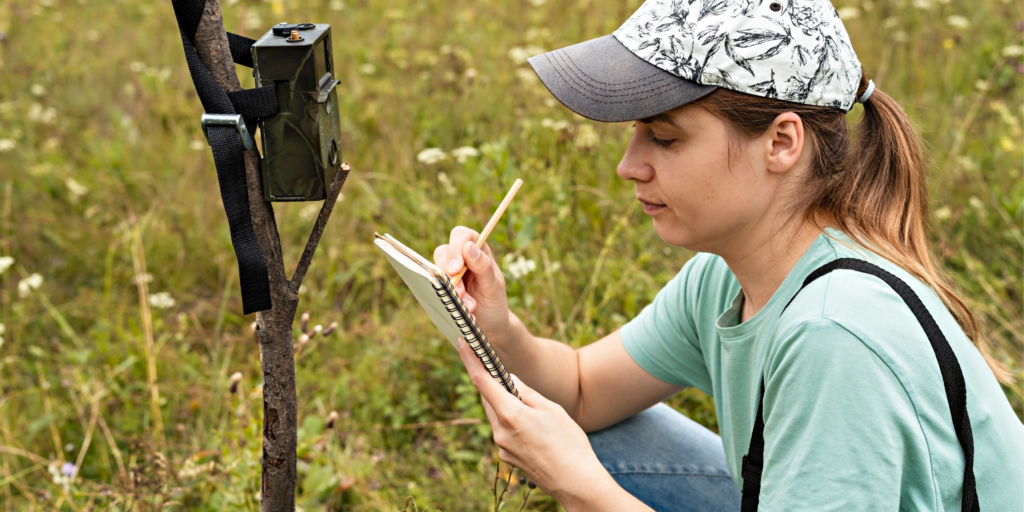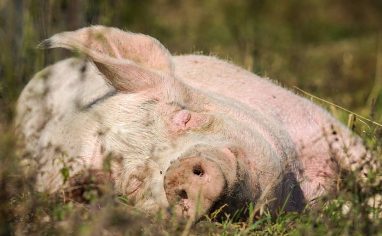
If you are reading this, you probably spend quite a lot of time with residents at sanctuaries. This is a useful resource for anyone involved in the care of animal residents and can help you better understand their wants and needs while keeping everyone safe and content. While this isn’t a complex science lesson on all the physiological responses that precurse observable behaviors, we do discuss various concepts from the field of ethology (animal behavior) in this resource. This resource provides a background on how observing and recording behavior in a sanctuary environment can help create a more robust care practice for each resident and create a safer and more compassionate environment for both staff and residents. Let’s get started!
The Importance Of Observation
Why is observation so important? Through observation, we gather useful information from the world. This can help us increase or deepen our understanding of a particular species, individual, situation, health condition, etc. We often talk about the importance of responding to an issue quickly. For example, seeking veterinary care if someone is ill or making adjustments to a resident’s living situation. However, to respond to an issue, one must first notice the sign(s) that there is an issue and recognize it as such, and this depends on your observation skills and ability to make sense of your observations. Observing residents through different lenses can go a long way in growing your understanding of their well-being. As caregivers, we may look for obvious physical signs of illness or injury, a vital aspect of caregiving! However, looking through a behavioral lens can provide a whole other layer to your understanding of sanctuary residents’ needs and interests.

The Caregiver’s Guide To Developing Your Observation Skills Resource
There is a seemingly never-ending list of skills one must learn to provide the high-quality, individualized care one would expect for a sanctuary resident or animal companion. The specific skills you need to learn depend on a variety of factors including the species you care for and each individual’s unique needs, but being observant is a skill that is important regardless of who you care for. Compared to physical skills such as safe restraint, nail/ hoof trimming, or administering medication, observation can be a bit more challenging both to teach and to refine, but being a skilled observer is just as important as proficiency in other caregiving tasks. Thoughtful observation and being able to contextualize and evaluate your observations are important caregiverSomeone who provides daily care, specifically for animal residents at an animal sanctuary, shelter, or rescue. skills that can help you provide the best care possible to your residents.
Clearly, observation is important, but how can we refine this very important skill? Learn more about developing your observational skills in the full resource here.
Who Are You Observing?

Different species have different behavioral repertoires (a list of behaviors someone is capable of) and individuals often exhibit unique behaviors. Because of this, it is important to consider who you are observing. Behavior provides a window into a resident’s world that, with careful observation and study, can tell us a great deal about what animals do when they are frightened, ill, or happy, as well as what they prefer, like, and dislike. From a sanctuary perspective, observing residents’ behavior can greatly influence how you provide them with basic care and medical treatment, choose social groupings, design enrichment plans, and more! When observing behavior, care staff must consider two sides of the behavior coin: the species and the individual.
The Species And The Individual
Learning about the history of your resident species can provide insight into how they navigate the world and what’s important to them as a species. This helps you develop an appropriate care plan for residents as you grow to understand them better. Learning the answers to the questions below can help you build a working foundation of species-specific behaviors and why they perform them. Some good questions to ask are:
- Where do they originate from?
- What are their feeding strategies?
- How do they protect themselves from predators?
- Where/when do they sleep?
- How do they interact with others of their species?
- How do they spend their time? i.e. activity budgets
In addition to understanding their motivations and behaviors, knowing the answer to these questions allows sanctuaries to provide proper living spaces, enrichment, nutrition, and other resources. Of course, residents are individuals and have their own personalities, preferences, and past experiences, both positive and negative, that influence their behavior and responses to certain stimuli.
Of course, at a sanctuary, you don’t always know what residents experienced before they came to you. When possible, getting as much info on their past and present individual history upon intake is important as it can help make sense of certain behaviors you see. This allows you to provide more focused care geared towards that individual. Let’s look at a couple of examples:
Example 1
Species:
Did you know many chickens (non-large breeds) will work through challenges for food even when other food is readily available? This is a behavior called “contrafreeloading”. Why is it important? Having this behavioral knowledge allows you to make care decisions that can have a positive effect on chicken residents by adding ways for them to obtain food in an engaging, interactive way.
Individual:
Helen came to the sanctuary after her human companion passed away. Her human companion always fed her from a little bowl in her hand before setting her food down for the day. This is evident in her behavior. When care staff provide food and put out PVC food puzzles, the chickens figure out how to move it around to get food. Helen follows the care staff around and looks up at them. As an individual, she chooses time with care staff feeding her a few bits before she goes to the food bowl for more food. She hasn’t approached the PVC puzzle.
Example 2
Species:
Lets look at an example of the importance of understanding the history of the resident species is in donkeys. Wild donkeys and the ancestors of sanctuary donkey residents formed little herds and were more likely to stand their ground when faced with a threat and less likely to show signs of pain and illness to avoid being targeted by predators. Why is that important? Well, this translates in a sanctuary environment to donkey residents being less likely to show obvious signs of illness or pain than some other species and therefore require close observation and attention if anything seems out of the ordinary. It also indicates the importance of donkeys being housed together.
Individual:
But, of course, everyone is an individual and it is important to treat them as such! Donald, for example, is certainly his own donkey. There isn’t much in the way of history except that he was housed alone in a small paddock. He is observed following care staff up the fence line as they go about their day a few times a week. When he isn’t following care staff, he is usually standing near the fence he shares with Lenny, a large goat resident next door. He appears indifferent about the other goat residents as he is only ever seen standing at the fence when Lenny is there. He currently lives with two other donkey residents but when they approach him he immediately backs away and goes to stand next to the fence he shares with Lenny. Considering what is known about his history, it may be appropriate to consider an alternate social housing option for Donald despite donkeys generally preferring the company of other donkeys.
As you can see, learning about both the species and the individual is imperative to observing and making sense of their behaviors, allowing staff to make informed decisions on care. Now that we have covered the importance of observation, let’s move into recording your observations.
The Importance Of Recording Behavior
Now that we have covered the importance of observing behavior, we can discuss the importance of recording WHAT you have observed! Why is recording our observations so important? Recording behaviors right from the start can help inform future interactions and determine needs that should be considered by caregivers. Recording behavior during the rescue and when they arrive at the sanctuary can give you a lot of information on how this individual copes with stressful situations. It is important to note those behaviors as they can also indicate key trigger areas. This allows care staff to work with residents to become accustomed to experiences that may be frightening for them such as loading into a trailer to go to the veterinarian’s office. The timing of recorded behavior is also important to consider when interpreting the notes. For example, the behavior of an incoming pig resident may be very different from how they will behave once settled. Avoid mislabeling the resident outright as “stubborn, aggressive, unfriendly” and simply describe the behavior and what happened in the environment. Be sure to observe and record their behavior when you introduce them to others and when they are settled. All together, you can learn a lot about this individual. Having their behavior on file can help paint a fuller picture of their experiences and emotional lives and help caretakers more fully provide for them.

In a perfect world, each resident would have a full daily behavioral assessment recorded and placed in their file. However, this is likely not feasible at many sanctuaries. This being said it is still vital that all residents be seen and checked daily and that staff keep an eye out for any behaviors that may indicate physical or psychological issues and record them. It can help to observe and record behavior from a distance to get a baseline reading. Then record how they behave throughout other interactions, especially potentially stressful events such as hoof/nail trims, transport, and new living spaces. This information can and should be used to identify areas where staff can work with residents to make them feel safer, more comfortable, and hopefully, active participants in future events.
Describing Behavior Versus Inferring Emotions

While we care about the emotional well-being of residents and there is room to note how you perceive their mood, it is important to also DESCRIBE behavior instead of simply writing, “Zandi was scared.” or “Zandi was being stubborn”. Here is what could be described about Zandi’s behavior in an example situation, providing much more insight into the situation and allowing for solutions and better care planning.
Zandi, an alpaca resident, stood still while I put his halter on and accepted light grooming with my hand as I picked straw out of his coat. He walked calmly while I led him from the pasture but stopped quite suddenly as we rounded to corner to walk to the trailer. I coaxed him forward and he took a few steps but then started pulling back, breathing heavily and looking around. I led him away from the trailer and he moved quickly back in the direction we came from. He stopped once we were around the corner and near the fence to his outdoor living area and inspected the grass.
This description gives context and allows the caregivers to develop a plan surrounding loading into a trailer that protects staff and Zandi while also preventing future staff or volunteers from writing Zandi off as “stubborn”.
Here is an alternative version that demonstrates why detailed descriptions and context are important:
Zandi stood while I put his halter on and accepted light grooming with a hand as I picked straw out of his coat. He walked calmly while I led him around a corner and into view of the trailer then stopped quite suddenly. With his ears perked forward, he swung his head around, looking back toward the pasture. He started humming, his body tense with his tail sticking staight out and his ears were somewhat back. Before I could respond, I heard either Felicity or Stargazer squeal. Upon hearing this, he made to turn back to the pasture where his companions remained. I attempted to redireat his attention and gently urged him to continue walking towards the trailer. He didn’t respond to this but kept making increasingly louder sounds and was clearly distressed so I turned him around and he moved quickly back towards the fence where Felicity was pacing and stood near her.
In both cases, Zandi stopped when he was near the trailer. They both show the descriptions are much more helpful than simply saying “Zandi was scared.” However, the details in the first description don’t consider the species and the individual. Zandi is an alpaca. Alpacas are very social and may develop strong bonds within their communities. Zandi arrived with Felicity and they are usually found near one another and Stargazer. It may be that the trailer isn’t the issue and that he will attempt to reunite with her when she is out of sight, regardless. With this observation of Zandi”s behavior recorded, the care team decides to bring Felicity with Zandi and work on loading into a trailer. This is a great example of staff preparing residents for future transport in a way that helps them understand what is being requested and make a positive association with loading into the trailer.
This example indicates the importance of considering the species and individual histories of the resident, Zandi, and also the importance of using factual descriptions of the incident over generalizations. That being said, there is scientific research and techniques, such as Qualitative Behavior Assessment that create space for observers to provide their thoughts on an individual’s emotional state. This, however, requires training and practice. We will cover Qualitative Behavior Assessment in another resource. The importance of recording this incident in Zandi’s file and using specific details allows staff to better understand how to interact with Zandi and approach transport.
Tips From The Field Of Ethology
Ethology For Sanctuaries
The information in this section pulls heavily from the field of ethology. We introduce topics that are used within this field to study animal behavior. Some of the concepts may feel too time-consuming for the resources of your sanctuary. That’s okay! Learning about the concepts and practices used in ethology can still provide you with a broader understanding of ways to incorporate observational practices into your care routine.
For now, we will introduce the following concepts from the scientific community and expound on them in a more advanced resource. Ethology is the study of animal behavior (generally in wild populations). We can use tools from this discipline to help create care plans that more fully capture the needs of residents in a sanctuary environment.
There are three concepts in particular to take note of; behavioral repertoires, ethograms, and activity budgets. These concepts can be particularly handy when developing an enrichment plan and considering the design of living spaces! Ethograms and behavioral repertoires may exist online for some species already. However, they often have a strong agricultural component and may include non-compassionate information. We are working on expanding our behavioral resources and providing general behavioral repertoires (see below) for resident species.
Behavioral Repertoire: Simply put, a behavioral repertoire is the full list of behaviors someone is capable of. Someone’s behavioral repertoire will generally change as they age and vary depending on sex, parental status, environment, and health.
Ethogram: An ethogram is a list of behaviors, each with a specific definition. These behaviors may be categorized by type e.g. social, food-related, solitary behaviors, etc… Unlike a behavioral repertoire, an ethogram may only include some of the behaviors a resident can perform.
Developing an ethogram can help ensure all observing staff are on the same page as to what each behavior precisely means when recording it in resident populations. Check out the example below:
Sample Ethogram
| Type of Behavior | Behavior | Code | Description of Behavior |
| Solitary | Groom self | GS | Resident uses hoof to scratch or horns to scratch or clean hooves or uses their mouth to groom coat |
| Sleep | S | Resident assumes species-specific positions for sleep, stays in one place, and is not alert to environmental changes | |
| Rest | R | Resident stays in one place but may be roused easily by environmental changes | |
| Locomote | L | Resident moves from place to place | |
| Food Related | Eat | E | Resident consumes hay, browse, treats, or grain |
| Look for Food | LF | Resident searches the environment for food items | |
| Drink | D | Resident consumes water or other liquids found in their environment. | |
| Social | Groom Others | GO | Resident stands or rests amongst their herd |
| Play | P | Resident engages in interactions with others that may involve locomotion, climbing, manipulating objects, or other activities that show a relationship between two or more interacting animals (this can look like confrontationalBehaviors such as chasing, cornering, biting, kicking, problematic mounting, or otherwise engaging in consistent behavior that may cause mental or physical discomfort or injury to another individual, or using these behaviors to block an individual's access to resources such as food, water, shade, shelter, or other residents. behavior but signals of strain are absent) | |
| Confrontational | Fight | F | Resident displays threatening behavior or vocalizations, charges an individual, bites, scratches, kicks or otherwise confronts another individual |
| Steal Food | SF | Resident approaches another resident that has located food in the environment and either by physical force or distraction, removes that food item from the vicinity of the other animal |
Activity Budgets: A measure of how much time someone spends performing behaviors in their behavioral repertoire.
Activity budgets can help you gain a better understanding of how residents spend their time. This, in turn, allows you to assess their well-being and discuss as a team whether any adjustments to their care routine would be beneficial. This information can help you develop a custom enrichment plan for individuals and groups, reevaluate their living spaceThe indoor or outdoor area where an animal resident lives, eats, and rests., or even discuss adjusting resident flocks or herds. However, to learn about how they spend their time you have to observe them. Unfortunately, care staff don’t generally have time to sit and watch a specific group of individuals all day. Because of this, you will need to determine when and for how long you will observe and how you are going to record their behaviors. While there are additional techniques, the following are a few ways to approach observation:
- Scan Sampling: This involves watching a single resident or a specific group of residents and writing down what they are doing every 60 seconds or 10 minutes or whatever interval of time you choose.
- Ad Libitum Sampling: This technique involves writing down any behavior that seems important to you about a single resident or group of residents over a period of time.
- Focal Sampling: This last technique requires you to watch a single resident for a set amount of time and write down everything they do during a set amount of time.
Using sampling techniques you can record the behavior using a preset observational record sheet or write it down using a shorthand code for each behavior to make it easier to record. You can also note whether an observed behavior is an event or sequence. An event is a single action that can be marked and a sequence is a behavior that can be marked and measured. For example, “Gogo hopped off the tree stump near another resident and continued hopping and rearing back and bringing their head down for several minutes rarely pausing (Playing)” is a sequence. An event would be “Gogo jumped”.
Okay, so we have looked at an example of an ethogram and learned about activity budgets. Here is an example of how this can be helpful:
You’ve noticed the goat residents engaging in confrontational behaviors a few times this week and you want a better idea of how they are spending their time and if environmental changes may be needed. Using an ethogram and a sampling technique you record the goats daily over a week. Upon analyzing the data you find multiple goat residents spend much of their time lying down and two particular goat residents exhibited confrontational behavior (pushing other residents away from resources) 9 times. You would like to decrease the confrontational behaviors and increase time spent engaging with their environment. You consider and research the behavior of goats. Goats in natural habitats spend much of their time exploring their environment and foraging. You notice that their living area is fairly bare of topographical interest and the pasture is also bare. You consider their care routine and feeding routine, placing one large pile of hay for everyone. You hypothesize that adding physical enrichment such as tree stumps and old large wooden spools and adding multiple opportunities to browse and eat throughout their living space will increase exploratory behavior and decrease the confrontational behaviors. Now, after making these changes, observe their reactions then let them adjust for a couple days. Then, follow up using the same observation technique you utilized before and see if there have been changes to their activity budget.
The above is a simplified version of the process as there are multiple scientific ways to observe behavior, depending on the situation. However, the information in this resource should prove useful in a sanctuary setting. By observing and recording behavior you come to learn what is” normal” for each individual and can pick up on any changes. To learn more, you can listen to our podcast “The Importance Of Observation In Animal Caregiving“.
Video As Record And Observation Tool
We know there probably aren’t enough hours in the day to accomplish the tasks you’d like to do as a caregiver. This is where using video can be helpful. You can set up a video using a phone with plenty of available storage or other available recording devices and set it up outside of the living area of residents (and out of reach!) and record their behavioral activities while you are finishing another task. When finished, you can come back and pick up the phone or other recording device. This allows you to watch and record their behavior when you have a moment. You can also upload it to any digital files you may have and share it with others on the care team. This gives the added benefit of allowing each caregiver to watch and write down the behaviors they see so you can compare them all and ensure you are all noting relatively the same thing! Be aware that if residents can see the camera they may be curious or alarmed and change their behavior due to its presence.
Benefits Of Behavioral Observations And Records
Whew! Well, this is a lot to cover in a single resource so we’d like to include an easy list of all the benefits that including behavioral observations and records in your care routine can have for the overall wellbeing of sanctuary residents. It can create a wonderful environment where everyone is an individual and has care plans developed with them in mind. Behavioral records can be helpful with:
- Adoption placement
- Arranging social groupings
- Individualized approaches to health checks
- Developing trauma-informed care plans
- Identifying causes of discomfort with new environmental changes
- Identifying health issues
- Providing continuity of care during staff changes
- Developing an individualized care plan
- Helping keep staff and residents safe
- Identifying stressors
We know this is a lot to take in so we will have a follow-up resource talking more about recording behavior. We hope you have found this and our many other resources helpful in building the best care plans for your residents. Stay tuned for more behavior resources! If you haven’t already, a good place to start is Behavior 101 For Animal Sanctuaries.
SOURCES:
The Caregiver’s Guide To Developing Your Observation Skills | Open Sanctuary Project
Observation: An Important Caregiving Tool | Open Sanctuary Project
Animal Behavior | Wild Welfare
Example Datasheets, Ethograms And Guidance | Animal Behavior Hub
Sampling Animal Behavior | Animal Behavioral Society Workshop
Sampling – Observing Animal Behavior | Orlando Science Center
Qualitative Behaviour Assessment | University Of Warwick Non-Compassionate Source
Describing, Recording, And Measuring Behaviour | Broom And Fraser’s Domestic Animal Behaviour And Welfare Non-Compassionate Source
Non-Compassionate Source?
If a source includes the (Non-Compassionate Source) tag, it means that we do not endorse that particular source’s views about animals, even if some of their insights are valuable from a care perspective. See a more detailed explanation here.








